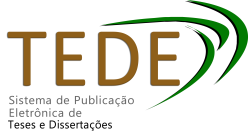| Compartilhamento |


|
Use este identificador para citar ou linkar para este item:
https://tedebc.ufma.br/jspui/handle/tede/737Registro completo de metadados
| Campo DC | Valor | Idioma |
|---|---|---|
| dc.creator | Rodrigues, Célio Diniz | pt_BR |
| dc.creator.Lattes | http://lattes.cnpq.br/1026221779868997 | por |
| dc.contributor.advisor1 | BATISTA, Jerias Alves | pt_BR |
| dc.contributor.advisor1Lattes | http://lattes.cnpq.br/1319645549100341 | por |
| dc.contributor.referee1 | Diniz, Eduardo Moraes | pt_BR |
| dc.date.accessioned | 2016-08-18T18:19:31Z | - |
| dc.date.available | 2014-01-30 | pt_BR |
| dc.date.issued | 2011-09-26 | pt_BR |
| dc.identifier.citation | RODRIGUES, Célio Diniz. STUDY OF DARK EXCITONS IN CARBON NANOTUBES USING DOPING: an approach via photoluminescence. 2011. 60 f. Dissertação (Mestrado em FISICA) - Universidade Federal do Maranhão, São Luís, 2011. | por |
| dc.identifier.uri | http://tedebc.ufma.br:8080/jspui/handle/tede/737 | - |
| dc.description.resumo | A baixa eficiência quântica da fotoluminescência observada em nanotubos de carbono semicondutores tem sido atribuída à existência de éxcitons escuros. Neste trabalho, realizamos estudos de espectroscopia de Fotoluminescência em amostra contendo praticamente um tipo de nanotubos encapsulados por moléculas de DNA. Foi observada claramente a existência de picos de emissão (bandas laterais) em aproximadamente 137 meV abaixo da transição excitônica principal 𝐸11 (nível mais baixo). Além disso, observamos um pico excitônico em 264 meV, aproximadamente o dobro da energia do primeiro éxciton escuro. Foi observado que a adição tanto de cargas positivas quanto negativas causa a supressão da luminescência. Medidas em amostras contendo vários tipos de SWCNTs encapsulados com SDS (dodecil sulfato de sódio) foram realizadas. Uma característica evidente foi a supressão da luminescência com adição de cargas positivas à uma taxa de −9,7 Å/nL, enquanto que a adição de cargas negativas promoveu a recuperação da luminescência à uma taxa muito mais rápida, de +25,6 Å/nL. Além da observação direta dos éxcitons escuros, observamos que através da dopagem seletiva é possível evidenciar a intensidade dos picos de fotoluminescência dos éxcitons escuros em relação aos éxcitons claros. Nosso objetivo foi estudar as influências do meio sobre as emissões de fotoluminescência em SWCNTs e, portanto, encontrar uma maneira de ressaltar as emissões dos éxcitons escuros em relação às emissões dos éxcitons claros. | por |
| dc.description.abstract | The low quantum efficiency of photoluminescence observed in semiconducting carbon nanotube has been attributed to the existence of dark excitons. In this work, we performed photoluminescence spectroscopy studies on samples containing practically one type of nanotubes encapsulated by DNA molecules. It was observed the existence of emission peaks (sidebands) at about 137 meV below the E11 excitonic transition (exciton bright). In addition, we observed an excitonic peak at 264 meV, about twice the energy of the first dark exciton. It was observed that the addition of both positive and negative charges causes the quenching of luminescence. Measurements in samples containing various types of SWCNTs encapsulated by SDS were done. A striking feature was the quenching of luminescence with addition of positive charges at a rate of −9.7 Å/nL, while the addition of negative charges promoted the recovery of the luminescence at a much faster rate of +25.6 Å/nL. Besides the direct observation of dark excitons, we found that through selective doping it was possible to identify a large enhancement of the dark excitonic emission compared to the bright one. Our goal was to study the influence of the environmental on the photoluminescence of SWCNTs and thus find a way to highlight the dark exciton emission from the bright exciton basement signal. | eng |
| dc.description.provenance | Made available in DSpace on 2016-08-18T18:19:31Z (GMT). No. of bitstreams: 1 Dissertacao Celio.pdf: 1563058 bytes, checksum: 7421930f54c58e686824f9df9ce8740f (MD5) Previous issue date: 2011-09-26 | eng |
| dc.description.sponsorship | FUNDAÇÃO DE AMPARO À PESQUISA E AO DESENVOLVIMENTO CIENTIFICO E TECNOLÓGICO DO MARANHÃO | pt_BR |
| dc.format | application/pdf | por |
| dc.language | por | por |
| dc.publisher | Universidade Federal do Maranhão | por |
| dc.publisher.department | FISICA | por |
| dc.publisher.country | BR | por |
| dc.publisher.initials | UFMA | por |
| dc.publisher.program | PROGRAMA DE PÓS-GRADUAÇÃO EM FÍSICA/CCET | por |
| dc.rights | Acesso Aberto | por |
| dc.subject | Fotoluminescência | por |
| dc.subject | Nanotubos de carbono | por |
| dc.subject | Éxcitons escuros | por |
| dc.subject | Photoluminescence | eng |
| dc.subject | Carbon nanotubes | eng |
| dc.subject | Dark excitons | eng |
| dc.subject.cnpq | CNPQ::CIENCIAS EXATAS E DA TERRA::FISICA::FISICA DA MATERIA CONDENSADA | por |
| dc.title | ESTUDO DE ÉXCITONS ESCUROS EM NANOTUBOS DE CARBONO USANDO DOPAGEM: uma abordagem via fotoluminescência | por |
| dc.title.alternative | STUDY OF DARK EXCITONS IN CARBON NANOTUBES USING DOPING: an approach via photoluminescence | eng |
| dc.type | Dissertação | por |
| Aparece nas coleções: | DISSERTAÇÃO DE MESTRADO - PROGRAMA DE PÓS-GRADUAÇÃO EM FISICA | |
Arquivos associados a este item:
| Arquivo | Tamanho | Formato | |
|---|---|---|---|
| Dissertacao Celio.pdf | 1,53 MB | Adobe PDF | Baixar/Abrir Pré-Visualizar |
Os itens no repositório estão protegidos por copyright, com todos os direitos reservados, salvo quando é indicado o contrário.




